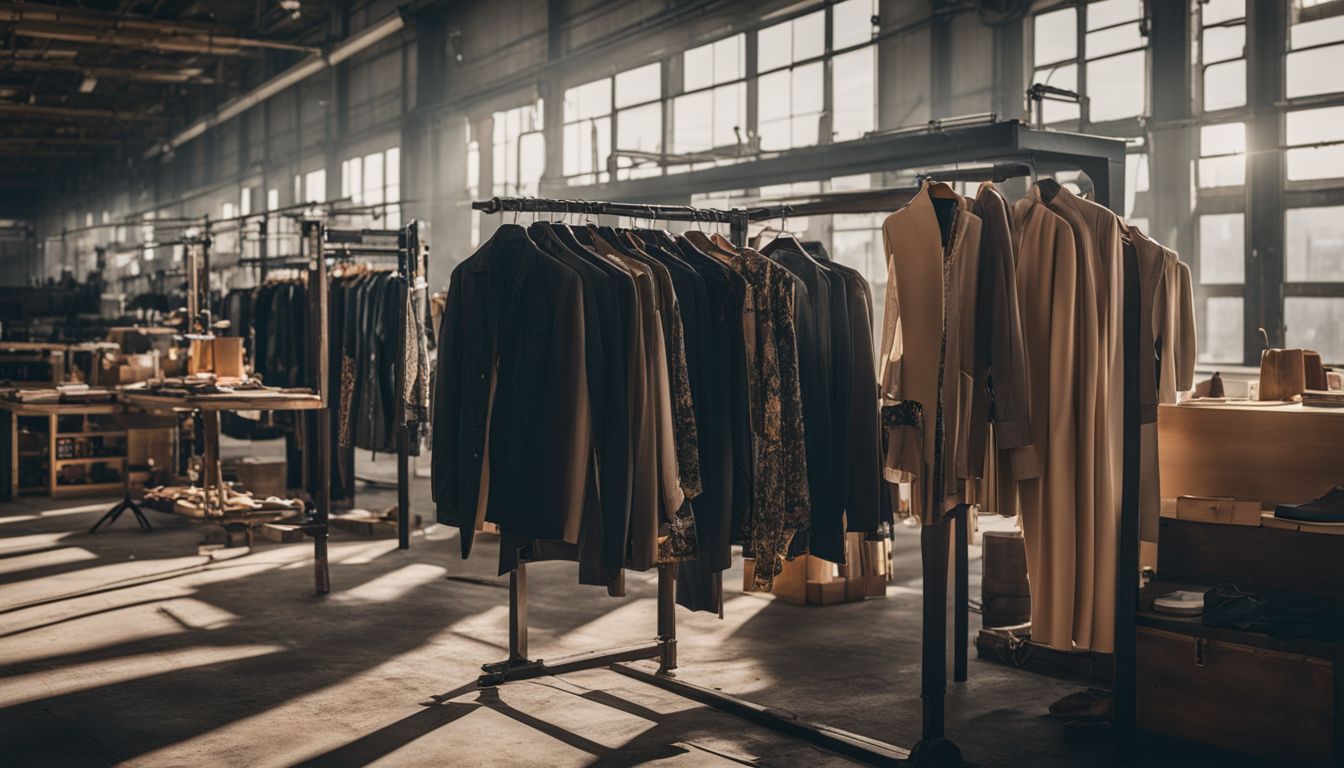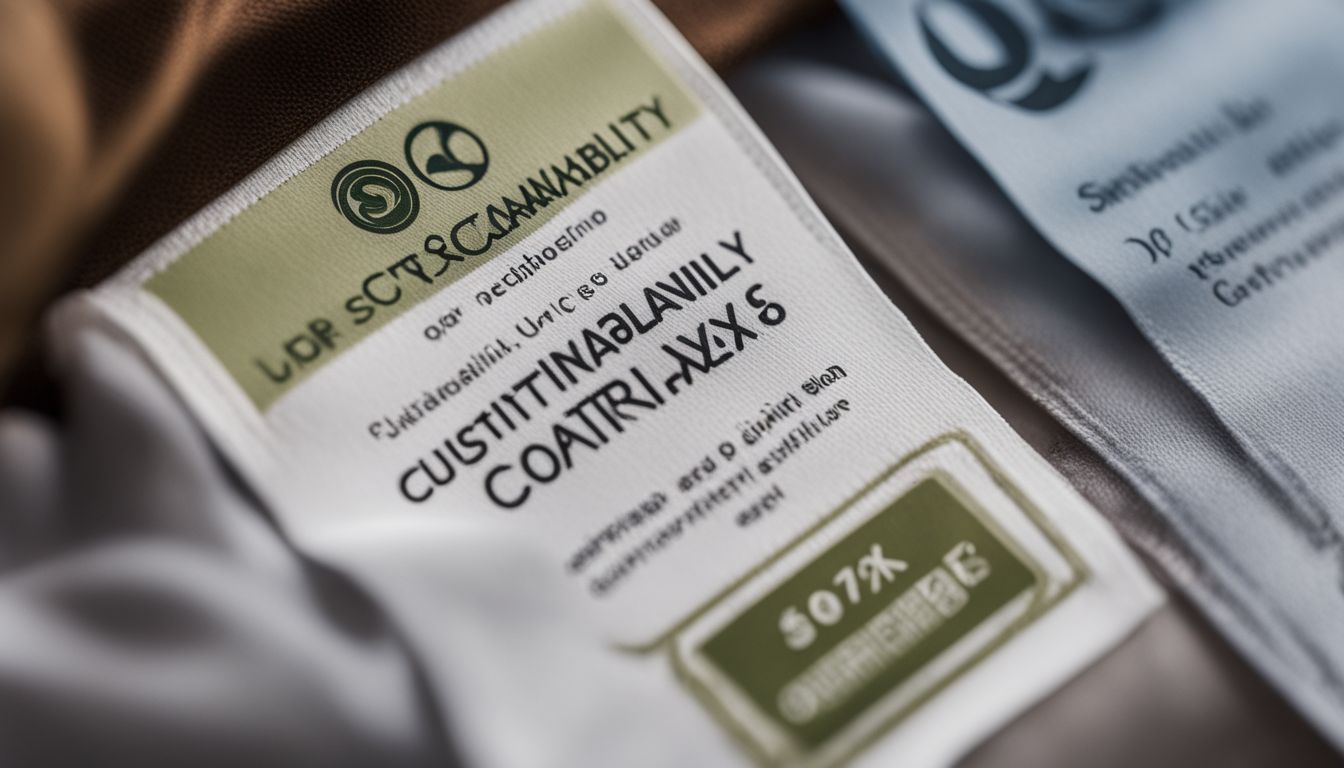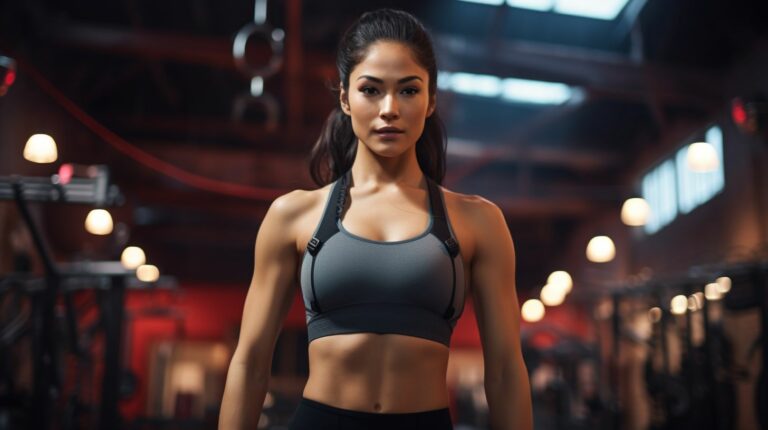What Is Sustainable Fashion? | Why Sustainability Is Important?
Have you ever wondered about the true cost of the clothes in your closet? The fashion industry is one of the largest contributors to environmental degradation and social injustices.
This blog post will unravel the concept of sustainable fashion, providing an easy-to-understand guide for ethical consumers looking to make a positive impact. Let’s dive into this green revolution together!
Key Takeaways
- Sustainable fashion aims to minimize environmental and social impact by considering materials, production processes, and ethical labor practices.
- Consumers can identify sustainable fashion through labels and certifications such as GOTS, Fair Trade Certified, Bluesign, Cradle to Cradle Certified, and OEKO-TEX Standard 100.
- When shopping for sustainable fashion, consumers should consider eco-friendly materials, natural dyes, low-impact manufacturing techniques, local sourcing, transparent supply chains,reduced water usage,minimal waste,and circular economy practices.
- Supporting sustainable fashion has environmental benefits like reducing pollution and greenhouse gas emissions. It also promotes fair working conditions for garment workers and contributes to a thriving economy by supporting local businesses.
Understanding Sustainable Fashion
Sustainable fashion is defined by its principles and aims to minimize environmental and social impact. It encompasses consideration of materials, production processes, and ethical labor practices.
Definition and principles
Sustainable fashion is about clothes, shoes, and add-ons made in the best way for our Earth. This mode of fashion fights fast fashion which hurts our world and people. It cuts down the bad effects on nature by choosing kind materials and cutting waste.
Fair work rules are also key in sustainable fashion. Think about how a dress comes to life from start to end to know if it’s really green or not. Make smart choices when you buy like picking used goods or brands that do good for our planet and people.
Environmental impact
Clothes make a big mark on our planet. The fashion world makes pollution and uses up water. It also harms the air with gas that heats up our earth. Not all clothes are equal though.
Sustainable fashion is different. It works to lower harm to our earth by using better materials and less waste. For example, it uses cotton grown without bad chemicals or recycled plastic instead of new one.
Also, it finds ways to use less water when making clothes. Most important are the methods that don’t leave old clothing as trash in the ground! This is how sustainable fashion helps fight against these hard hits on earth’s health.
Social impact
Sustainable fashion improves lives. It gives fair pay and safe work places to people who make clothes. It takes care of workers in the fashion chain. When they get good money, they can live well.
This type of fashion also helps communities grow stronger. With fair wages, workers can feed their families and send their kids to school. They no longer have to worry about not having enough money for food or bills.
Identifying Sustainable Fashion
To identify sustainable fashion, consumers should look for labels and certifications that indicate ethical practices, consider the materials and production processes used in the clothing, and ensure that brands prioritize fair labor practices.
Labels and certifications
Labels and certifications play a key role in identifying sustainable fashion. They provide consumers with valuable information about the environmental and social impact of a garment. Here are some important labels and certifications to look for:
- Global Organic Textile Standard (GOTS): GOTS-certified products meet strict criteria for organic fibers, environmentally friendly processing, and fair labor practices.
- Fair Trade Certified: This label ensures that workers involved in the production process receive fair wages and have safe working conditions.
- Bluesign: Bluesign-certified products meet high standards for their entire lifecycle, from raw materials to final product, ensuring minimal impact on the environment.
- Cradle to Cradle Certified: This certification evaluates a product’s use of safe and sustainable materials, its recyclability, and its impact on human health.
- OEKO-TEX Standard 100: Products with this label have been tested for harmful substances, ensuring they are safe for consumer use.
Consideration of materials and production processes
When choosing sustainable fashion, it is important to consider the materials used and the production processes involved. Some key factors to keep in mind include:
- Eco-friendly materials: Look for clothing made from organic cotton, recycled polyester, hemp, or other sustainable fibers. These materials have a lower environmental impact compared to conventional fabrics.
- Natural dyes: Many sustainable brands use natural dyes derived from plants or other renewable sources. These dyes are less harmful to the environment and reduce the release of toxic chemicals into waterways.
- Low-impact manufacturing: Sustainable fashion often involves using energy-efficient practices and minimizing waste during the production process. Look for brands that prioritize reducing their carbon footprint and implementing sustainable manufacturing techniques.
- Local sourcing: Supporting locally sourced materials reduces transportation emissions and supports local economies. Look for brands that emphasize using local suppliers and manufacturers.
- Transparent supply chains: Ethical brands are committed to transparency and provide information about their supply chain, ensuring fair labor practices and safe working conditions for workers.
- Reduced water usage: Sustainable fashion brands focus on reducing water consumption throughout the production process by implementing innovative technologies or choosing materials that require less water during cultivation or dyeing processes.
- Minimal waste: Sustainable fashion aims to minimize waste by using fabric scraps in creative ways or recycling them into new garments or accessories.
- Circular economy practices: Some sustainable brands embrace circular economy principles by designing products that can be easily repaired, recycled, or repurposed at the end of their lifecycle.
Ethical labor practices
Ethical labor practices are an important aspect of sustainable fashion. They focus on ensuring fair wages, safe working conditions, and the empowerment of workers throughout the supply chain.
This means that everyone involved in making our clothes, from the farmers who grow the cotton to the factory workers who sew them together, should be treated with respect and paid a living wage.
By supporting brands that prioritize ethical labor practices, we can help improve the lives of garment workers and promote social justice in the fashion industry. It’s crucial to look for certifications or labels that indicate a brand’s commitment to ethical labor practices.
These certifications may include Fair Trade or Worker-friendly labels.
Benefits of Supporting Sustainable Fashion
Supporting sustainable fashion has numerous benefits. It helps protect the environment, promotes ethical labor practices, and contributes to a more sustainable and equitable economy.
Read on to learn how you can be part of this positive change.
Environmental benefits
Sustainable fashion offers significant environmental benefits. By using eco-friendly materials, minimizing waste, and promoting ethical labor practices, sustainable fashion reduces the industry’s negative impact on the environment.
It also focuses on reducing pollution and greenhouse gas emissions caused by the production and disposal of clothing. Sustainable fashion encourages consumers to buy less and choose higher quality items that are made to last longer, thereby reducing the overall demand for new clothing.
Additionally, supporting sustainable brands helps drive innovation in sustainable manufacturing techniques and promotes a more circular economy where materials are reused or recycled instead of ending up in landfills.
Social benefits
Sustainable fashion brings important social benefits. It promotes fair working conditions and ensures that garment workers are paid a living wage. By supporting sustainable fashion brands, consumers can contribute to improving the livelihoods of these workers, who are often exploited in the fast fashion industry.
Sustainable fashion also values diversity and inclusivity by prioritizing ethical labor practices and empowering workers throughout the supply chain. Furthermore, it encourages transparency, allowing consumers to make informed choices about the brands they support and ensuring that their purchases align with their ethical values.
Overall, sustainable fashion fosters a more equitable and socially responsible fashion industry for all involved.
Economic benefits
Supporting sustainable fashion has numerous economic benefits. Firstly, investing in quality and durable clothing may initially cost more than fast fashion items, but in the long run, it can save you money as these garments are designed to last longer.
Additionally, by shopping from ethical brands and supporting local designers, you are contributing to the growth of small businesses and helping to create job opportunities within your community.
Moreover, sustainable fashion promotes transparency in the supply chain, which means that workers receive fair wages and work in safe conditions. This helps to improve livelihoods and reduce poverty levels.
How to Support Sustainable Fashion
Support sustainable fashion by buying from ethical brands, embracing secondhand shopping and clothing swaps, extending the lifespan of your clothing through repair and upcycling, supporting local and independent designers, and spreading awareness and advocating for change.
Buying from ethical brands
Supporting sustainable fashion starts with making conscious choices when purchasing clothing. By buying from ethical brands, you can ensure that your clothes are produced in a responsible and environmentally-friendly way. Here are some ways you can do this:
- Look for certifications and labels: Many ethical brands will display certifications such as Fair Trade or GOTS (Global Organic Textile Standard) on their products. These certifications indicate that the brand meets certain social and environmental standards.
- Research the brand’s values and practices: Before making a purchase, take the time to learn about the brand’s commitment to sustainability. Look for information on their website about their materials sourcing, production processes, and labor practices.
- Opt for sustainable materials: Choose clothing made from eco-friendly materials like organic cotton, hemp, or recycled fabrics. These materials have a lower impact on the environment compared to conventional fabrics.
- Support transparent brands: Look for brands that value transparency and provide information about their supply chain and production methods. They should be open about where their clothes are made and who makes them.
- Consider durability and quality: Instead of buying fast fashion items that are meant to be worn only a few times, opt for high-quality pieces that will last longer. Investing in well-made garments reduces waste and saves money in the long run.
Embracing secondhand shopping and clothing swaps
Embrace secondhand shopping and clothing swaps to support sustainable fashion.
- Shop for secondhand clothing: Look for gently used items at thrift stores, consignment shops, and online platforms.
- Attend clothing swaps: Swap clothes with friends, family, or community members to give new life to pre-loved garments.
- Explore vintage stores: Find unique and timeless pieces from different eras that add character to your wardrobe.
- Consider rental services: Rent clothes for special occasions instead of buying new ones that may only be worn once.
- Donate and buy from charity shops: Not only can you find great deals, but the proceeds often go towards supporting charitable causes.
- Participate in online communities: Join social media groups or websites dedicated to swapping or selling used clothing items.
- Take care of your clothes: Properly clean, mend, and care for your garments to extend their lifespan and reduce the need for constant replacements.
- Foster a culture of sharing: Encourage friends and family to borrow or lend clothes for events or occasions instead of buying new outfits.
Extending clothing lifespan through repair and upcycling
Repairing and upcycling clothes can help extend their lifespan and reduce waste. Here are some ways to do it:
- Learn basic sewing skills so you can mend small tears, replace buttons, or fix zippers yourself.
- Take damaged clothes to a tailor for more complex repairs or alterations.
- Get creative with upcycling by turning old clothes into something new and unique. For example, you can transform an old t-shirt into a tote bag or repurpose jeans into shorts.
- Host clothing swap events with friends or in your community to exchange clothes you no longer wear but are still in good condition.
- Donate unwanted clothes to thrift stores or organizations that accept used clothing.
Supporting local and independent designers
Supporting local and independent designers is another way to promote sustainable fashion. Here’s how you can do it:
- Seek out local designers: Look for local fashion designers in your community or region. These designers often have a smaller carbon footprint since their supply chains are shorter, and they may use locally sourced materials.
- Attend local fashion events: Keep an eye out for local fashion shows, pop-up shops, and markets that feature independent designers. By attending these events, you can discover unique and sustainable clothing options.
- Invest in quality pieces: Local designers often prioritize craftsmanship and durability, creating pieces that are meant to last. By investing in high-quality items from independent designers, you can reduce the need for fast fashion purchases.
- Collaborate with local makers: Consider collaborating with local makers or couturiers to create custom pieces or alter existing garments. This not only supports local talent but also adds value to your wardrobe without contributing to waste.
- Spread the word: Share your favorite local designers on social media or through word-of-mouth recommendations. By raising awareness about their work, you can help support their businesses and encourage others to choose sustainable options.
Spreading awareness and advocating for change
Spreading awareness and advocating for change are crucial steps in promoting sustainable fashion. By sharing information about the environmental and social impacts of the fashion industry, we can educate others and inspire them to make more conscious choices when it comes to their clothing purchases.
Social media platforms, blogs, and community events can be powerful tools for spreading awareness about the importance of sustainable fashion. Additionally, getting involved in advocacy efforts such as supporting legislation that promotes ethical practices in the fashion industry can create systemic change.
Together, we can work towards a future where sustainable fashion becomes the norm rather than an exception.
Conclusion
In conclusion, sustainable fashion is about making conscious choices as consumers to support clothing and accessories that are produced in the most environmentally-friendly and socially responsible way possible.
By embracing ethical brands, opting for second-hand items, repairing and upcycling clothes, supporting local designers, and spreading awareness about the importance of sustainability in fashion, we can all contribute to a more sustainable future for the industry.
Let’s make a difference through our shopping decisions and help create positive change.
FAQs
1. What is sustainable fashion?
Sustainable fashion refers to clothing and accessories that are made with materials and production methods that have minimal negative impact on the environment, animals, and workers.
2. How can I be an ethical consumer in the fashion industry?
To be an ethical consumer in the fashion industry, you can choose to buy from brands that prioritize sustainable practices, such as using organic or recycled materials, providing fair wages and safe working conditions for their workers, and minimizing waste.
3. Why is sustainable fashion important?
Sustainable fashion is important because it helps reduce pollution, conserve resources like water and energy, protect animal welfare, promote fair labor practices, and combat climate change.
4. Where can I find sustainable fashion options?
You can find sustainable fashion options by researching eco-friendly brands online or visiting stores that specialize in ethically-made clothing. You can also look for certifications like Fairtrade or GOTS (Global Organic Textile Standard) labels to ensure your purchases align with sustainability values.









